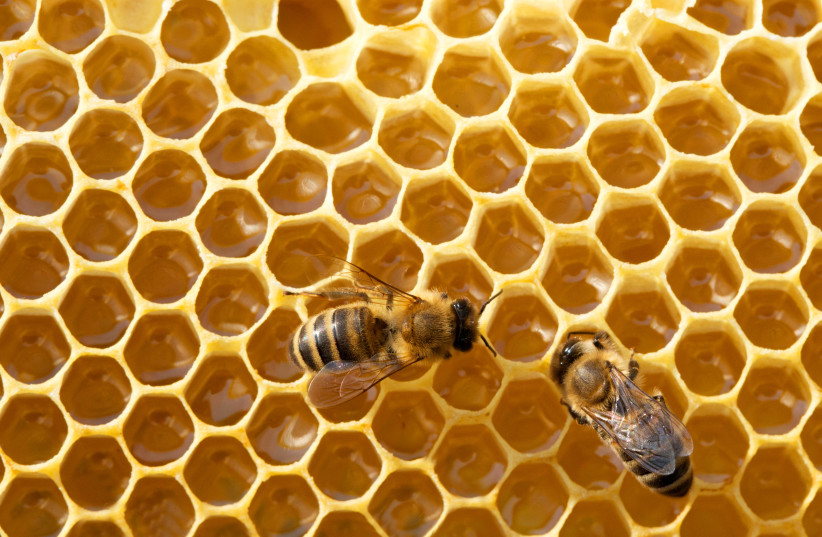From Rosh Hashanah, the Jewish New Year, straight through Simhat Torah, for nearly an entire month, table salt is banished to the pantry cupboard. And in its stead, almost every Jewish meal is adorned with honey.
During the High Holy Day season, the status of honey is elevated from accoutrement or condiment to that of symbol. Central to the entire Jewish holiday season, while honey certainly symbolizes sweetness and our desire for a sweet new year, that is but a small part of the role this honey plays. It is also a symbol of happiness, of success, and of health. It is a symbol of hope.
In Jewish tradition, honey is not just simply honey. It is a complicated matter to be studied and to be debated. A food that is mentioned in the Bible, it has spurred many a rabbinical discussion and lively debate.
Honey is mentioned 55 times in the Bible – but only twice as bee honey. At all other times, each mention of honey refers to date honey. The first biblical mention of bee honey is found in the story of Samson the Great. In Judges 14:8, Samson scoops honey out of the carcass of a lion where the bees were nesting. The next time it is mentioned is in Samuel 14 when, after the battle of Michmash, Jonathan the son of King Saul, eats a honeycomb.
Honey from bees raises a huge quandary for the rabbis. By all rights, honey should not be kosher at all. And yet, it is a central component of Jewish ritual and tradition!

In the Talmudic Tractate of Bechorot (not Berachot) on the very bottom of page 7a and continued on page 7b, the rabbinic argument begins: “Anything that comes from a non-kosher animal is forbidden and everything that comes from a kosher animal is permitted.” That explains why the milk of a camel and the eggs of a vulture are forbidden while the milk of a cow and the eggs of a chicken are kosher.
But bees are not kosher – so how and why is honey kosher? The answer is that unlike milk, which is a product of the cow’s digestion, nectar is not actually eaten or digested by bees. Rather, it is transferred and transported inside the bee and then delivered to the honeycomb where the process continues outside of the bee.
The bottom line is that in making honey, bees pollinate plants allowing vegetation to grow and bear fruit. But remember the revulsion we all experienced as school children when we learned that the sweet treat we so enjoyed was nothing other than bee vomit.
We would probably have been happier not to have learned that honey comes not from the bee’s stomach, but rather, from a gland called the hypopharyngeal.
It is that gland, inside the bee, that begins the essential process of honey-making. It is there that bee enzymes break down the nectar that bees then transport to hives where they spit it into the honeycomb. Inside the honeycomb, the liquid thickens and is transformed into what we call honey.
And bees are not the only insects to participate in the honey-making process. Several other insects produce honey in a similar fashion. Honeydew Honey, also called Forest Honey, is the product of aphids, and that honey is also the subject of much debate. Some designate that honey as kosher, others as non-kosher.
The importance of bees
It is not just Jews who spend so much time thinking about and eating honey. There is a long and rich literature about bees, and their importance cannot be understated.
Bees are essential to the world. In fact, one-third of the world’s food is pollinated by bees. And one-half of the world’s fibers and oils are pollinated by bees. Keeping the bee population high is essential to the world’s safety.
Bees make it easy for us. They are not very fussy about what they pluck to make their honey. That is why there are so many different honeys. If bees are in a field of clover, they make clover honey. If they are near an orange grove, you get orange blossom honey. The same is true with blueberry and alfalfa, sage, avocado, and even buckwheat.
Each of these honeys tastes dramatically different. They are natural honeys, not honey infused with flavors like strawberry or lemon, or even chocolate, although those are available. These are honeys from the flowers that bees pollinated.
During the Middle Ages, an exciting new educational tradition was introduced to Jewish children – one that still continues in certain religious communities. On the first day of school, Hebrew letters were written in honey. Young students would lick up the letters that were on the board. It was a beautiful and brilliant initiation into the sweetness of learning. To help celebrate learning, along with the honey came honey cakes and honey pastries – these were called honig lekach.
In Yiddish, honig means honey. And lekach, both in Yiddish and in Medieval German, means to lick. Any way you enjoy your honey this season – whether it is bee honey or silan, the Persian name for date honey, whether you taste it straight up or in cookies, or in cakes, may it be a symbol for “good.”
The writer is a social and political commentator. Watch his TV show, Thinking Out Loud, on JBS. Read his latest book, Thugs.
